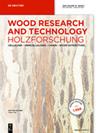栖息地、密度、木质素结构和萃取处理对水肿木材热软化特性的影响:对 87 种木材标本的研究
IF 1.6
3区 农林科学
Q2 FORESTRY
引用次数: 0
摘要
本研究旨在揭示热软化温度的多样性,并确定决定该温度的因素。为此,我们测量了 15 种软木和 72 种硬木样本在水饱和状态下木材径向的热软化特性。木材样本取自日本林业和林产品研究所的木质贮藏室。由于冷却速度的不同会改变木材的机械特性,因此对加热和冷却过程一致的样本进行了动态粘弹性测量。随着木材密度的增加,存储弹性模量和损耗弹性模量呈线性增加,与木材种类无关。然而,热软化温度(本研究中定义为损耗切线的峰值温度)与栖息地的密度、解剖特征、树种、纬度和年降雨量无关。在研究热软化温度与木质素结构的关系时,发现热软化温度与木质素芳香族的丁晴基比率(丁晴基/(丁晴基+愈创木基))呈负相关。这表明木质素结构较致密的木材品种的热软化温度较高,支持了之前研究表明的木材热软化温度与甲氧基含量之间的相关性。本文章由计算机程序翻译,如有差异,请以英文原文为准。
Influence of habitat, density, lignin structure, and extraction treatment on thermal-softening properties of water-swollen wood: a study of 87 wood specimens
This study aims to reveal the diversity of thermal-softening temperatures and identify the factors that determine this temperature. To achieve this, the thermal-softening properties of the radial direction of wood were measured under water-saturated conditions for 15 softwood and 72 hardwood specimens. Wood samples were obtained from the xylarium of the Forestry and Forest Products Research Institute, Japan. A dynamic viscoelastic measurement was performed on samples with uniform heating and cooling history because the difference in cooling rate can alter in the mechanical properties of wood. The storage and loss elastic moduli increased linearly as wood density increased, regardless of the wood species. However, the thermal-softening temperature (defined in this study as the peak temperature of loss tangent) was unrelated to the density, anatomical features, species, latitude, and annual rainfall in the habitat. When the relationship between thermal-softening temperature and lignin structure was investigated, a negative correlation was observed between the thermal-softening temperature and the syringyl ratio (syringyl/(syringyl+guaiacyl)) of lignin aromatics. This indicates that the thermal-softening temperature is higher for wood species with denser lignin structures, supporting the prior research showed correlation between thermal-softening temperature and methoxyl group content of wood.
求助全文
通过发布文献求助,成功后即可免费获取论文全文。
去求助
来源期刊

Holzforschung
工程技术-材料科学:纸与木材
CiteScore
4.60
自引率
4.20%
发文量
83
审稿时长
3.3 months
期刊介绍:
Holzforschung is an international scholarly journal that publishes cutting-edge research on the biology, chemistry, physics and technology of wood and wood components. High quality papers about biotechnology and tree genetics are also welcome. Rated year after year as one of the top scientific journals in the category of Pulp and Paper (ISI Journal Citation Index), Holzforschung represents innovative, high quality basic and applied research. The German title reflects the journal''s origins in a long scientific tradition, but all articles are published in English to stimulate and promote cooperation between experts all over the world. Ahead-of-print publishing ensures fastest possible knowledge transfer.
 求助内容:
求助内容: 应助结果提醒方式:
应助结果提醒方式:


